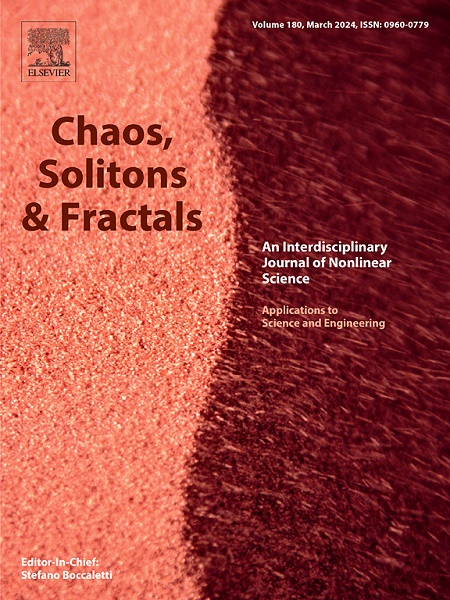A parameter estimation method for neural mass model based on the improved chimp optimization algorithm and Riemannian geometry
IF 5.6
1区 数学
Q1 MATHEMATICS, INTERDISCIPLINARY APPLICATIONS
引用次数: 0
Abstract
Neural mass model (NMM) serves as an effective tool for understanding and exploring the complex dynamics of brain systems. Accurately estimating the model parameters of NMM is highly important for building brain models driven by observed electroencephalogram (EEG) data. However, existing methods for comparing model output with observed data primarily focus on one-dimensional linear comparisons, overlooking the high-dimensional nonlinear dynamics and Riemannian geometry characteristics of EEG data. To address this issue, we propose a novel parameter estimation method for NMM based on the improved chimp optimization algorithm (ChOA) and Riemannian geometry. First, ChOA is improved by incorporating the Aquila optimizer (AOChOA) is used to improve the convergence efficiency and accuracy of the nonlinear optimization problem. Then, a novel loss function based on the Riemannian geometry of symmetric positive definite matrices (LRSPD) is constructed to capture the high-dimensional nonlinear dynamics of EEG signals. Finally, we validate the effectiveness of the proposed method by using the model output with fixed model parameters and real EEG signals as observed data, respectively. When using the model output with fixed model parameters, the loss function LRSPD yielded more accurate parameter estimation results compared to others, with the fitted model closely matching the dynamics of the observed data. When using real EEG data, the proposed method successfully recovered differences in EEG dynamics for subjects at different consciousness levels. Additionally, our study reveals the neural mechanisms of decreased consciousness level in patients with disorders of consciousness (DOC), characterized by increased inhibitory neural activity of the brain.
基于改进黑猩猩优化算法和黎曼几何的神经质量模型参数估计方法
神经质量模型(Neural mass model, NMM)是理解和探索脑系统复杂动力学的有效工具。准确估计NMM模型参数对于建立基于脑电数据驱动的脑模型具有重要意义。然而,现有的模型输出与观测数据比较方法主要集中在一维线性比较上,忽略了脑电图数据的高维非线性动力学和黎曼几何特征。为了解决这一问题,我们提出了一种基于改进的黑猩猩优化算法(ChOA)和黎曼几何的NMM参数估计方法。首先,通过引入Aquila优化器(AOChOA)来改进ChOA,提高非线性优化问题的收敛效率和精度。然后,基于对称正定矩阵的黎曼几何构造了一种新的损失函数来捕捉脑电图信号的高维非线性动态。最后,分别以固定模型参数的模型输出和真实脑电信号作为观测数据,验证了所提方法的有效性。当使用固定模型参数的模型输出时,损失函数LRSPD的参数估计结果比其他方法更准确,拟合的模型与观测数据的动态更接近。当使用真实脑电数据时,该方法成功地恢复了不同意识水平被试的脑电动态差异。此外,我们的研究揭示了意识障碍(DOC)患者意识水平下降的神经机制,其特征是大脑抑制性神经活动增加。
本文章由计算机程序翻译,如有差异,请以英文原文为准。
求助全文
约1分钟内获得全文
求助全文
来源期刊

Chaos Solitons & Fractals
物理-数学跨学科应用
CiteScore
13.20
自引率
10.30%
发文量
1087
审稿时长
9 months
期刊介绍:
Chaos, Solitons & Fractals strives to establish itself as a premier journal in the interdisciplinary realm of Nonlinear Science, Non-equilibrium, and Complex Phenomena. It welcomes submissions covering a broad spectrum of topics within this field, including dynamics, non-equilibrium processes in physics, chemistry, and geophysics, complex matter and networks, mathematical models, computational biology, applications to quantum and mesoscopic phenomena, fluctuations and random processes, self-organization, and social phenomena.
 求助内容:
求助内容: 应助结果提醒方式:
应助结果提醒方式:


